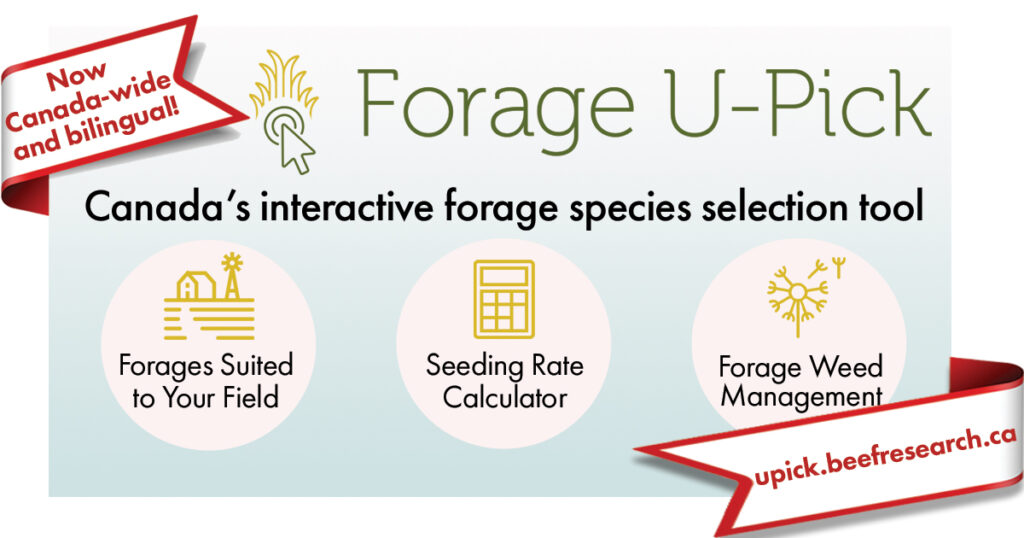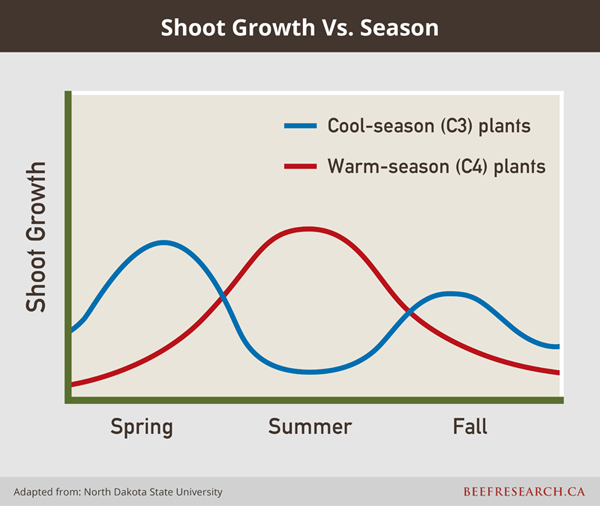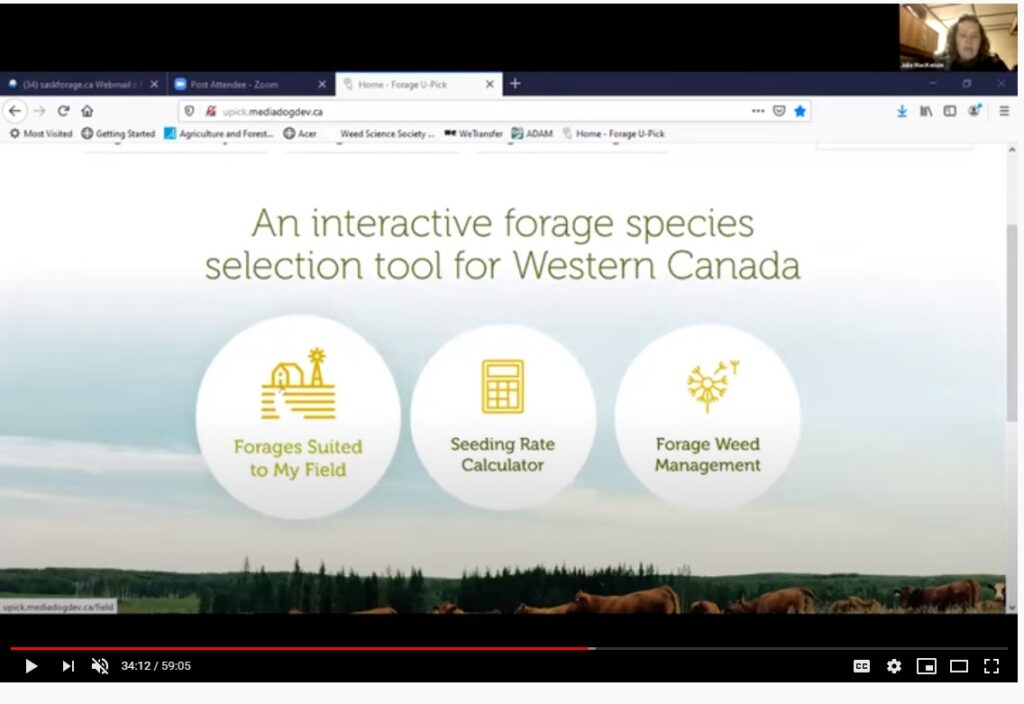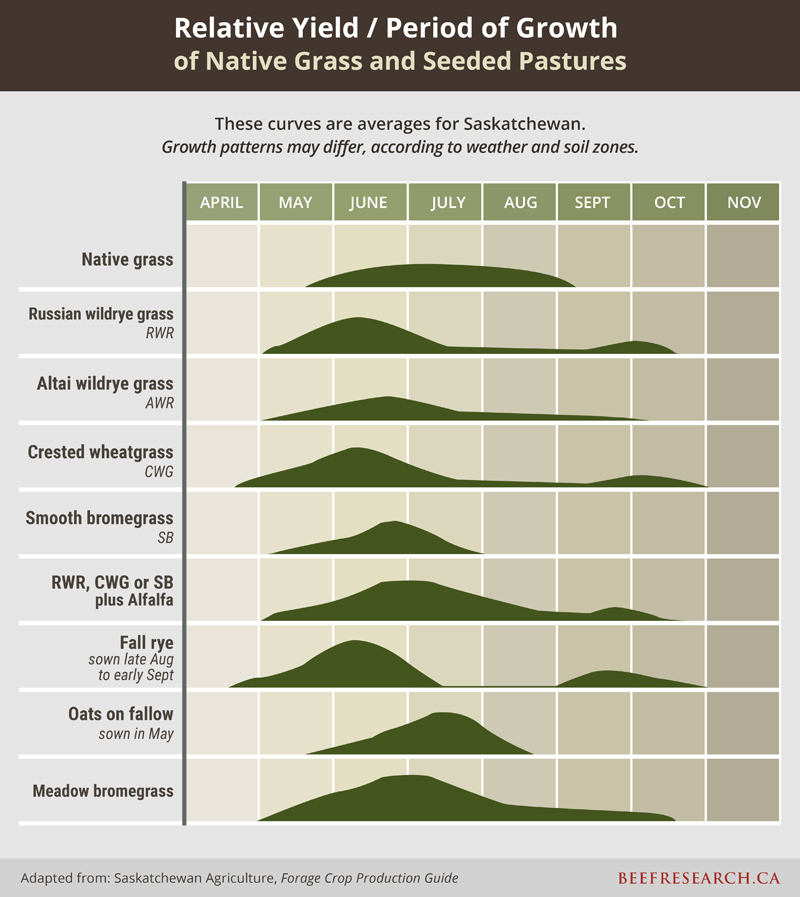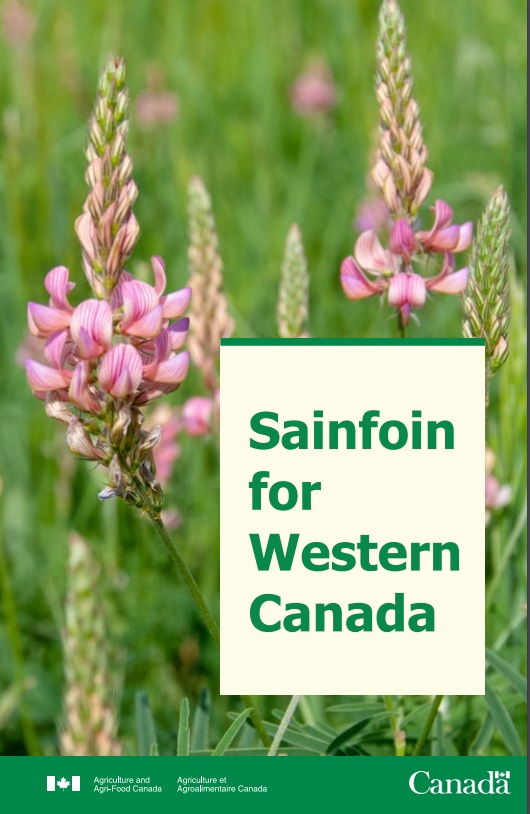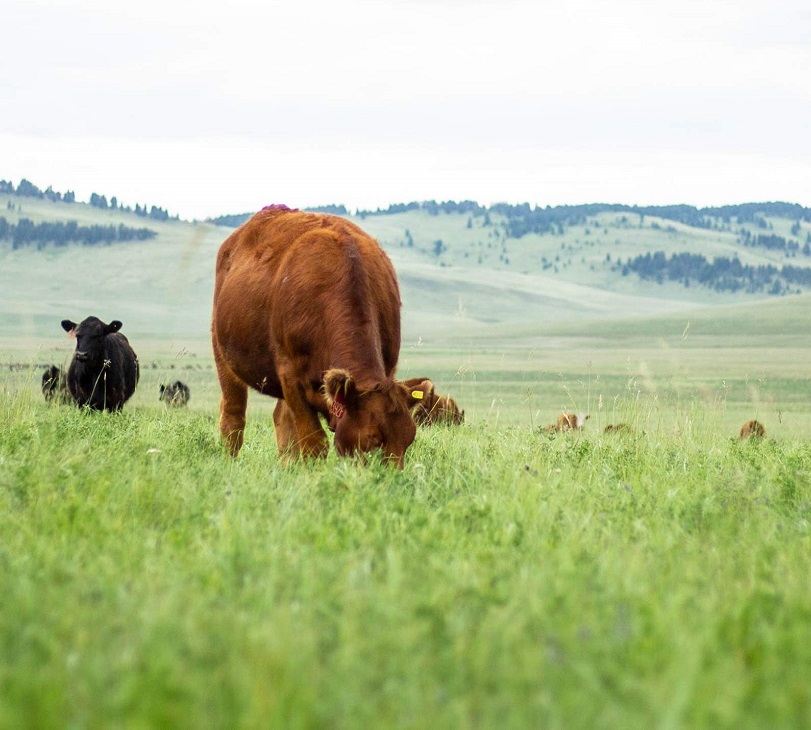
Forages are a major feed component for the cow-calf and backgrounding sectors of the beef industry, and are made up of grasses, legumes, forbs and shrubs. Eighty percent of a beef animal’s diet over its lifetime comes from forages. Forages are consumed by grazing livestock and utilized as stored feed. Forage species have different yield potential and nutritional quality, which can influence the productivity of beef cattle.
Climate, soil characteristics, local environmental conditions and management objectives determine the best forage species and variety for each planting area and application. Forages add to the diversity and beauty of agricultural and urban landscapes, provide habitat for wildlife, can play a role in soil improvement and water conservation, reduce erosion, and contribute to the carbon cycle as a carbon sink.
Forages, both tame and native, are the single largest land use component of Canadian agriculture covering approximately 70 million acres. Native rangelands, which have been declining due to conversion to cropland, are now less than 35 million acres (14 million hectares) and the remaining acres are dedicated to the production of annual and perennial tame forages, fodder and seed1.
| Key Points |
|---|
| Forage species have different yield potential and nutritional quality, which can influence the productivity of beef cattle |
| Forages can be categorized as annual or perennial. Annual plants complete their growth cycle in a single growing season and are perpetuated by seed. Perennials grow indefinitely, with well-established and properly managed stands essentially permanent |
| Sod forming grasses spread by rhizomes and stolons and form a dense stand while bunch grasses remain as individual plants that develop dense clusters of tillers |
| Grasses may also be classified as warm season or cool season with differences in leaf anatomy and enzymes altering how they carry out photosynthesis |
| With proper management, legumes can stimulate soil biological activity, improve soil structure, aeration and water-holding ability, reduce erosion and increase organic matter |
| Alfalfa is the most common legume used as a forage for beef cattle, however risk of bloat requires careful management or use in a mixture that includes grasses or other non-bloating species |
| Native stands often have improved soil properties such as lower soil bulk density, higher organic matter and less weed invasion than tame forage stands |
| Management of a forage stand relies upon optimizing the level of utilization that allows for maximum forage use without damage or negative impact to the forage plant, including both above and below ground growth |
| Well managed pasture with a significant legume component is one of the most sustainable feed sources for cattle. It is often the most profitable for producers because the nutritive value of the mixture meets livestock demands and can produce suitable animal gains with fewer inputs |
| Fluctuations in forage nutrient content are correlated with the annual growth cycle of the forage |
Grasses
For detailed descriptions (including uses, yield, quality, hardiness, adaptability, and seeding recommendations) along with pictures of Canadian tame grasses and legumes, and native Western Canadian grasses, visit the Forage U-Pick tool.
Most cultivated grasses grown in Canada, referred to as tame species, are introduced species from Europe or Asia that have been bred and adapted to perform in Canadian conditions. The unique characteristics that various species have will provide an advantage over other species under different growing conditions and production types. Some grasses have superior adaptation to climate and soil conditions such as heat, cold, drought, flooding, salinity and acidity. Differences in growth habits make grasses more suitable for different production systems whether grazing or stored forages. The fibrous root systems of grasses stabilize soil and reduce erosion caused by wind and water.
Grasses can be categorized as annual or perennial. Annual plants complete their growth cycle in a single growing season and are perpetuated by seed. Examples include annual ryegrass, annual bluegrass, millet and sorghum. Perennials grow indefinitely, with well-established and properly managed stands essentially permanent. While vegetation above ground may die back during winter, perennials regrow from the roots again in spring. They propagate by both tillers and seeds. Examples of perennial grasses include tall fescue, bromegrasses, timothy, reed canarygrass, big bluestem, wheatgrasses, perennial ryegrass, Kentucky bluegrass and switchgrass.
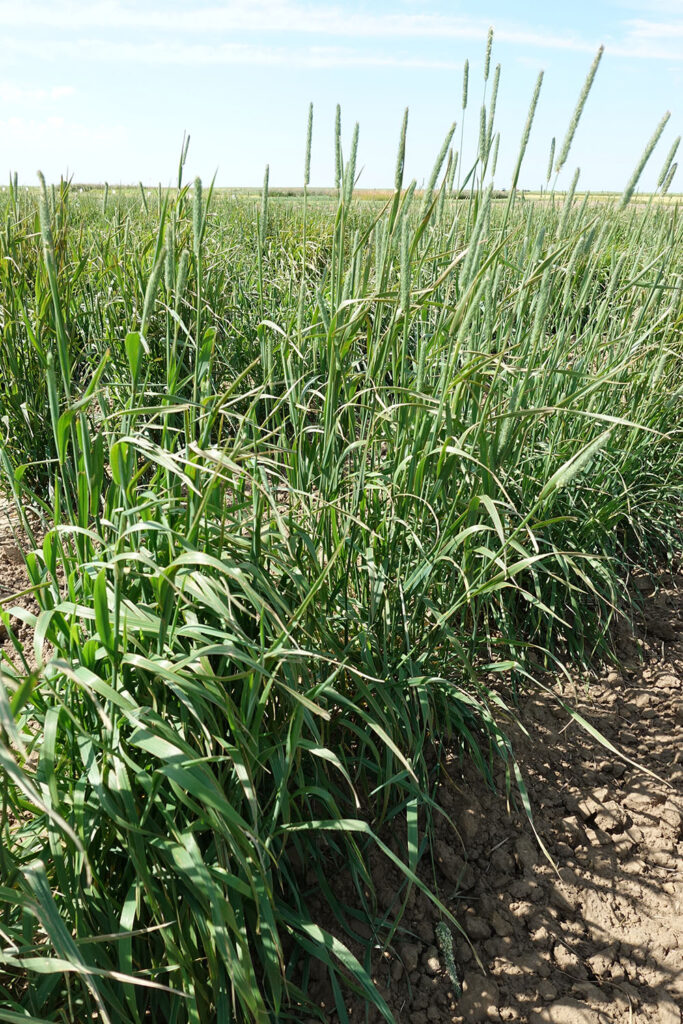
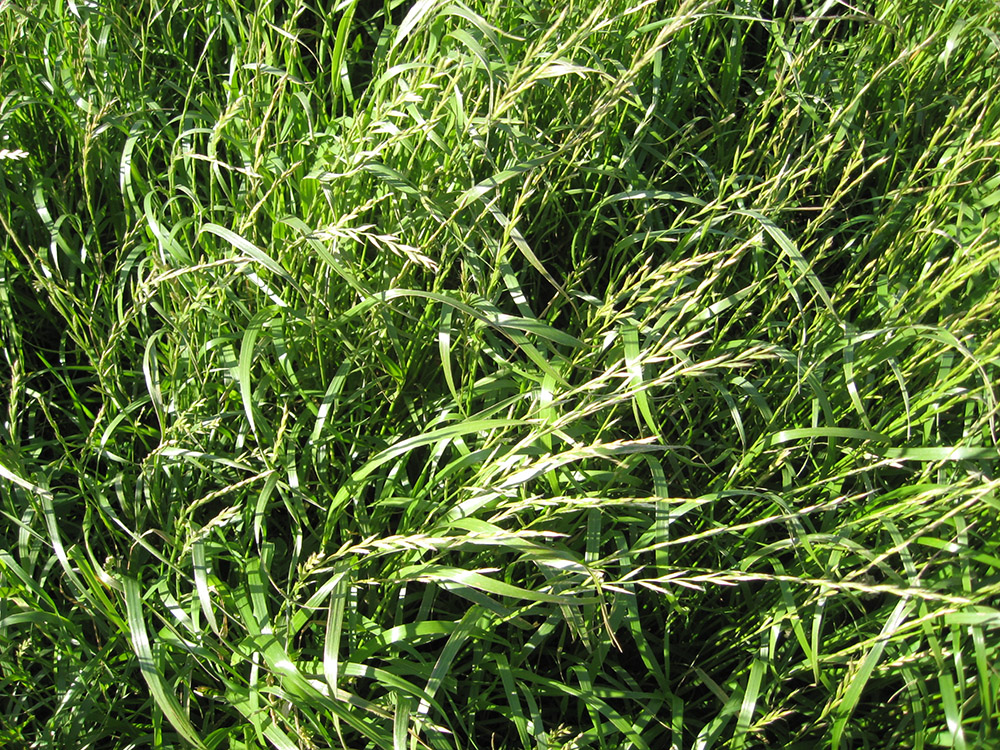
Grasses have either sod forming or bunch grass growth patterns. Sod forming grasses spread by rhizomes and stolons and form a dense stand while bunch grasses remain as individual plants that develop dense clusters of tillers. Rhizomes and stolons are modified stems, with rhizomes extending laterally underground while stolons grow above ground. Grasses produce more rhizomes when precipitation is favourable, and less during periods of drought. Vigorously growing grasses produce greater weight and length of rhizomes than overgrazed plants. Management practices that promote forage growth also encourages new rhizome growth and generally increases the productivity of the stand. Stolons are mostly at the soil surface with new shoots growing from the nodes. Because of this growth pattern, sod forming grasses will fill in spots in a stand and form a tight web of plants. New plants develop from buds in crown tissue and from apical meristems at the tips of rhizomes and stolons. New vertical shoots can also develop from the nodes on the rhizomes or stolons. Rooting depth varies between species. Some sod forming species, such as bluegrass, have shallow rooting depths while more drought tolerant species, such as smooth bromegrass, have a higher proportion of their roots distributed deep within the soil profile.
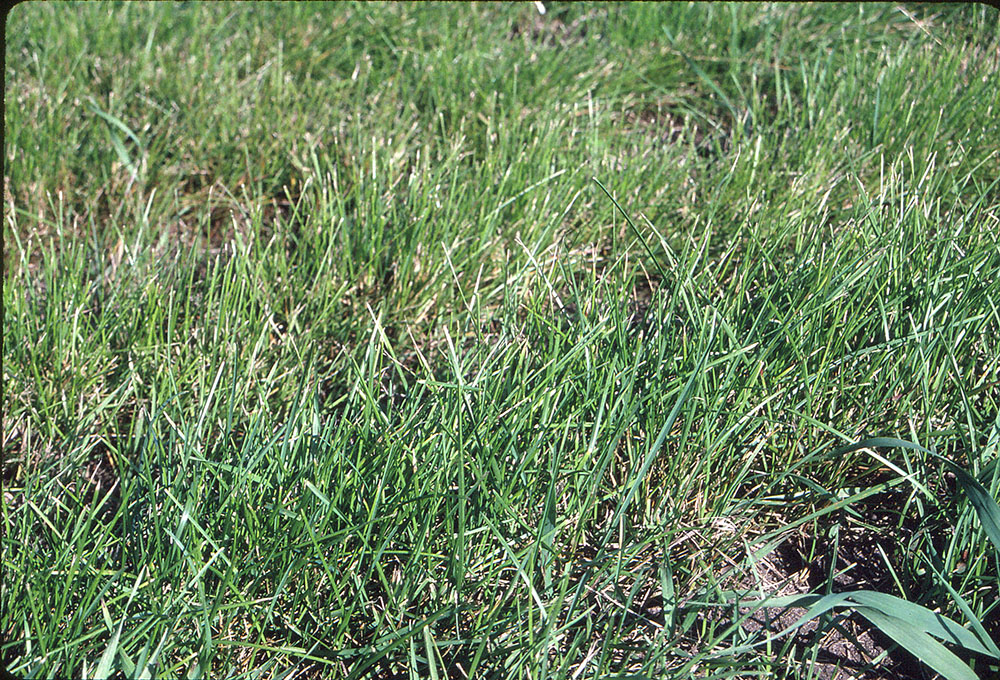
Bunch grasses grow in distinct clumps or tufts of vegetation. While this can increase risk of weed infestation due to the spaces between individual plants, bunchgrasses are often very productive as they put a greater proportion of their energy into above ground structures. They grow by tillering at or near the soil surface without rhizomes or stolons, and new plants grow up from within the plant. Bunch grasses tiller more actively and keep more leaf area near the soil surface, with most of the seasonal growth as vegetative stems. Bunch grasses are less competitive in forage mixtures than rhizomatous (sod forming) grass species, which makes them a suitable choice for mixtures with legumes. Timothy, annual and perennial ryegrass, orchard grass, tall fescue and crested wheatgrass are examples of bunch grasses.
Certain grasses, such as timothy, elongate a high percentage of their tillers to produce seed heads. When the stems are in the elongation phase, grazing can remove the growing points, resulting in slower regrowth. Grasses which form a high percentage of vegetative tillers, such as meadow bromegrass, keep the tiller growing points close to the soil surface; thus, they are not removed by grazing and regrowth will be more rapid.
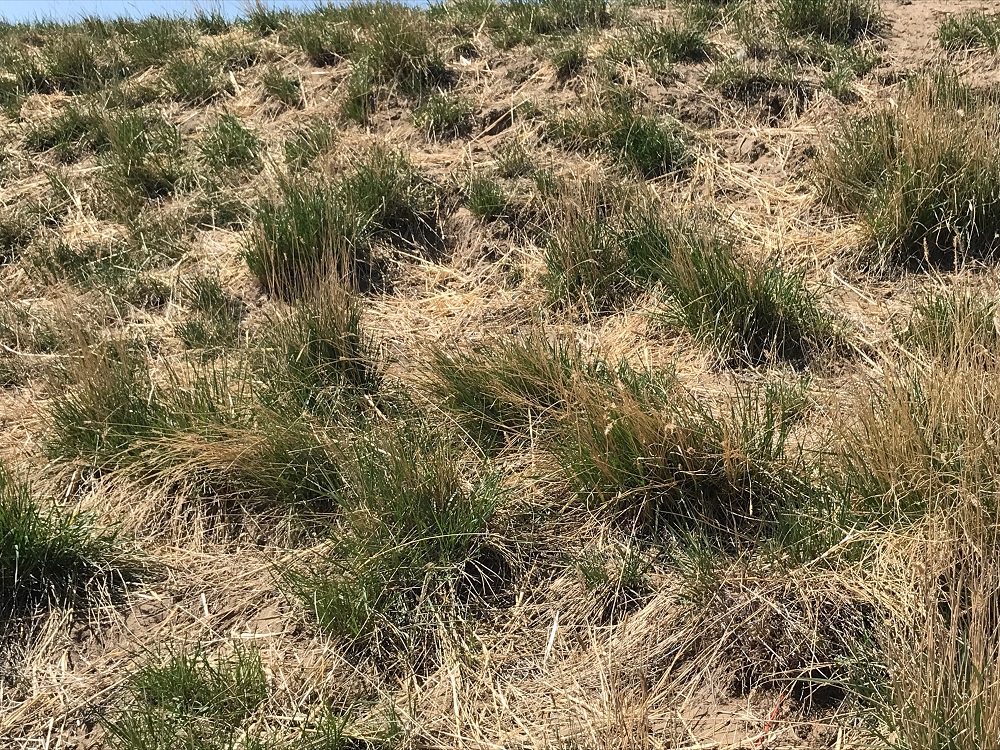
Grasses may also be classified as warm season or cool season with differences in leaf anatomy and enzymes altering how they carry out photosynthesis. These differences impact their optimal growing conditions, forage quality, nitrogen and water use and their seasonal production profile.
In Canada, most tame grass species are cool season species with optimum growth occurring at temperatures between 18 and 24 degrees Celsius. Perennial cool season grasses include bromegrass, fescues, ryegrass and timothy. Other cool season crops that might be used for feed include barley, oats, rye and wheat. Cool season forages, such as crested wheatgrass, initiate growth earlier in the spring. Native cool season plants include slender wheatgrass, plains rough fescue, needle-and-thread and June grass. These cool season plants grow well during cool, wet conditions and produce more protein than warm season plants. They produce most of their annual growth before mid-July and often go dormant as temperatures rise. Spring and early summer are best for grazing. Spring growth can also be stockpiled for summer grazing to hold over animals until growth of cool season grasses resumes as the lower temperatures and rains return in late summer or early fall.
In Canada, most tame grass species are cool season species with optimum growth occurring at temperatures between 18 and 24 degrees Celsius. Perennial cool season grasses include bromegrass, fescues, ryegrass and timothy. Other cool season crops that might be used for feed include barley, oats, rye and wheat. Cool season forages, such as crested wheatgrass, initiate growth earlier in the spring. Native cool season plants include slender wheatgrass, plains rough fescue, needle-and-thread and June grass. These cool season plants grow well during cool, wet conditions and produce more protein than warm season plants. They produce most of their annual growth before mid-July and often go dormant as temperatures rise. Spring and early summer are best for grazing. Spring growth can also be stockpiled for summer grazing to hold over animals until growth of cool season grasses resumes as the lower temperatures and rains return in late summer or early fall.
Warm season plants tolerate heat and drought and include corn, sorghum, sorghum-sudan grass, sudan grass and millet, as well as native grasses like big and little bluestem, side-oats grama, Indiangrass and blue grama. These grasses experience peak growth in the summer and may be better suited to grazing in late summer or fall. Learn more about the differences between cool and warm season plants photosynthetic processes here.
When utilizing sorghum, sorghum-sudan grass or sudan grass, be aware of the risks of prussic acid.
High prussic acid levels can be found in young growth and/or levels can increase quickly with sudden disruptions to growth occurs such as frost, drought or cutting. To mitigate the risks, grazing should not occur until the grass has reached 18-26 inches. If frost or drought occurs during grazing, animals should be removed from the pasture immediately. Grazing can be resumed one to two weeks after frost or drought.
If fields containing sorghum, sorghum-sudan grass or sudan grass must be harvested right away and prussic acid levels are a concern, forage can be made into silage or dried hay. Silage should be safe after 6-8 weeks of fermentation while the curing process for hay production significantly reduces prussic acid levels.
Understanding the differences in growth patterns between cool and warm season forages is important to ensure appropriate timing for grazing and capturing maximum sunlight throughout the growing season.
Common grasses used in beef cattle production in Canada include timothy, tall fescue, smooth and meadow bromegrass, orchard grass, Kentucky bluegrass, ryegrasses, crested wheatgrass and reed canary grass. Timothy grass is the most common species of grass cultivated for forage throughout eastern Canada. Highly palatable, it is often sown in a mixture with other types of grasses and legume forages for improved yield performance. In western Canada, wheatgrasses and bromegrasses are commonly used due to their greater drought tolerance. To increase yield, flexibility and economic returns, producers across Canada may also use annual cereal crops, including barley, oats, wheat, triticale, millet, sorghum, sorghum-sudan grass, sudan grass and corn, as forage for grazing, cutting and baling as greenfeed, stored feed and extended grazing.
Legumes
Legumes are forages that have seeds in pods and creeping or large tap roots. Both annual and perennial legumes are used as livestock feed and are also recognized for their ability to improve soil. With proper management, legumes can stimulate soil biological activity, improve soil structure, aeration and water-holding ability, reduce erosion and increase organic matter. Many legumes grown in Canada are cool season forages and start growth in early spring.
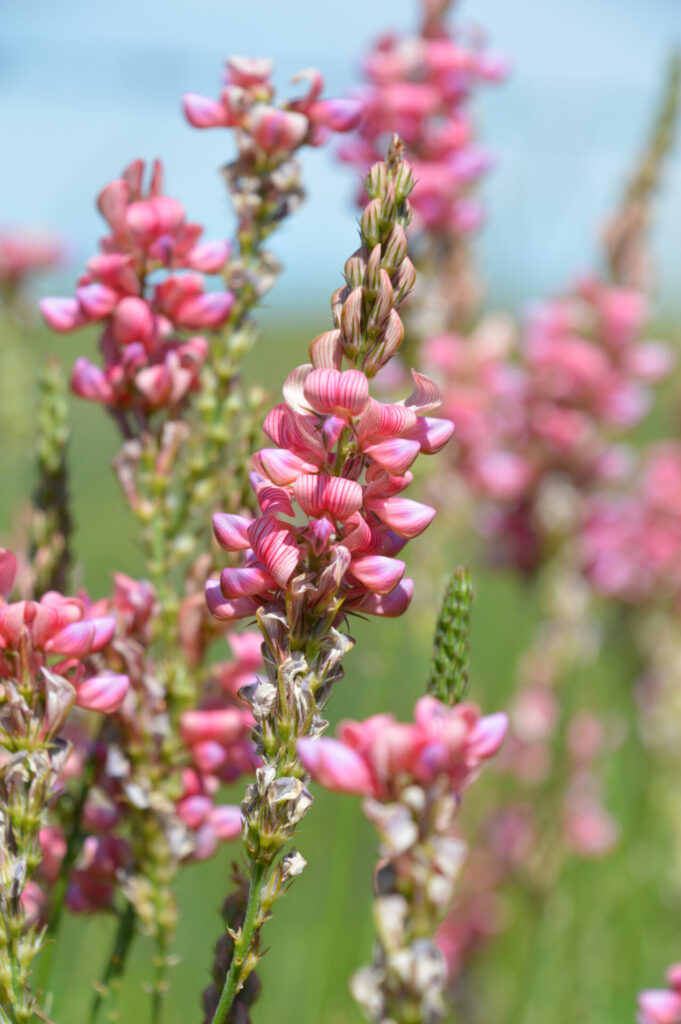
Legumes fix nitrogen, meaning they are able to produce most of the nitrogen they require to grow. Both grain (pulse crops) and forage legumes have the ability to fix nitrogen. Annual legumes grown for grain include lentils, soybeans and peas. Annual forage legumes include varieties such as the 40-10 forage pea as well as vetches. Forage legumes include biennials such as white blossom sweet clover and yellow blossom sweet clover, and perennials such as alfalfa, alsike clover, birdsfoot trefoil, cicer milkvetch, red clover, purple prairie clover, sainfoin and white clover.
Many legumes, such as alfalfa, have a deep root system that helps to withstand drought. Birdsfoot trefoil effectively uses excess water and may reduce salinity or drainage problems. Others, like white clover, are susceptible to drought due to their shallow, fibrous roots. Legumes can be grown as forage, including for grazing or as stored forage such as hay, greenfeed or silage, or turned under as green manure to improve fertility and organic matter in soils. Legumes generally have higher protein levels than grasses and tend to have a less rapid decline in digestibility as they mature1. Legumes typically require more management than grass stands, due to fertility and soil factors, and are often less persistent than grasses. However, they also tend to produce higher quality, higher yielding feed.
Some legume species initiate growth faster in the spring, which is important for early season grazing or for capturing maximum sunlight energy throughout the growing season. Growth curve differences exist among legumes; legumes with a long growth curve are easier to harvest especially when grazing. Long growth curves allow the plant to grow longer compared to having quickly reached the objective of setting seed. For example, native legumes like purple prairie clover start growth later in the spring and set pods and seeds later than most tame legumes.
The ability of legumes to maintain nutritional quality at advanced stages of growth is linked to leaf to stem ratio as leaves tend to be more digestible with lower fibre levels than stems. Birdsfoot trefoil is an example of a species that maintains its quality at more advanced stages, because it does not have thick stems like alfalfa, therefore maintaining an overall higher leaf to stem ratio.
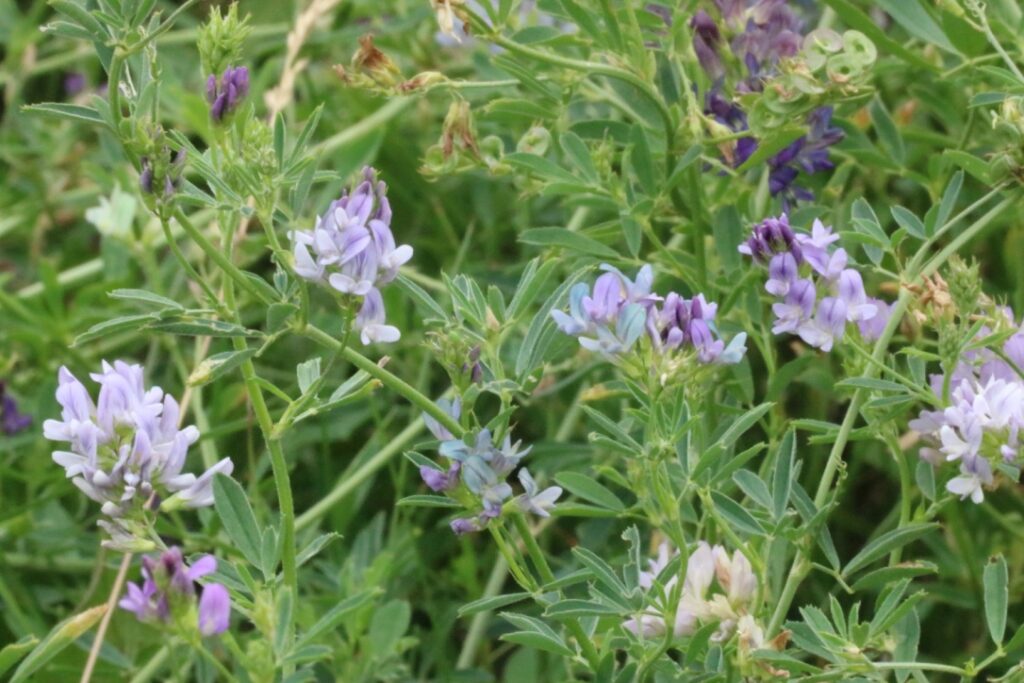
Legumes vary in their ability to stay productive over time as physiological differences in legumes affect their ability to thrive and survive. The nature of the roots and the leaf surface affect a species’ ability to thrive under heat, cold, drought or flooding. Plants with long tap roots can generally withstand drought better than shallow rooted plants. Alfalfa can remain in a forage stand for a significant number of years but may only last 3-5 years, while sainfoin and red clover have demonstrated less persistence. Reduced longevity can be due to a number of factors, including disease or poor winter hardiness. soil conditions, as well as mismanagement and overgrazing in mixed legume-grass stands. Research continues on legumes that increase pasture productivity while also improving longevity, energy content, winter hardiness, and persistence in forage mixtures.
Alfalfa is the most common legume used as a forage for beef cattle, however risk of bloat requires careful management or use in a mixture that includes grasses or other non-bloating species. Bloat occurs when the fine parts of legume plants break down very quickly and create a frothy bloat in the rumen. This condition is more likely when grazing plants during their vegetative stage. Some legume species are bloat conducive while others, such as sainfoin, birdsfoot trefoil and cicer milkvetch are bloat safe.
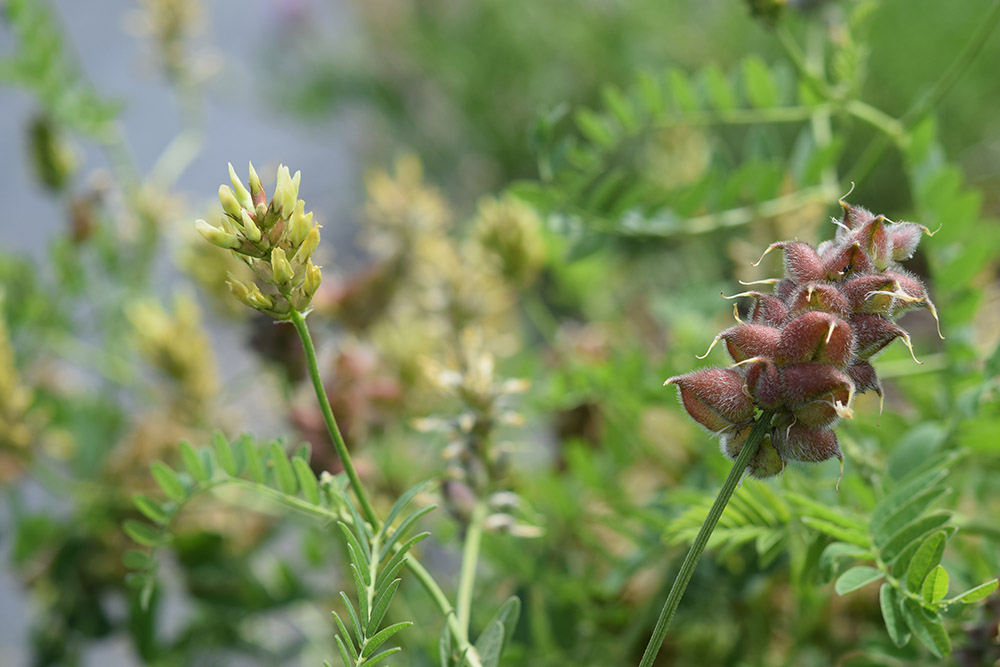
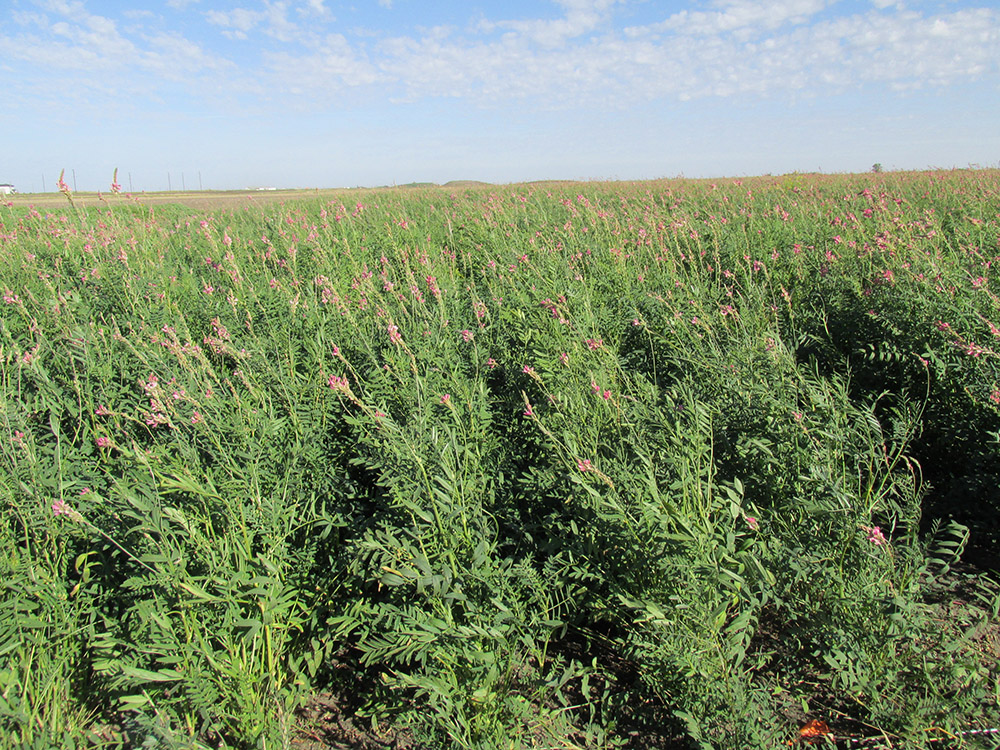
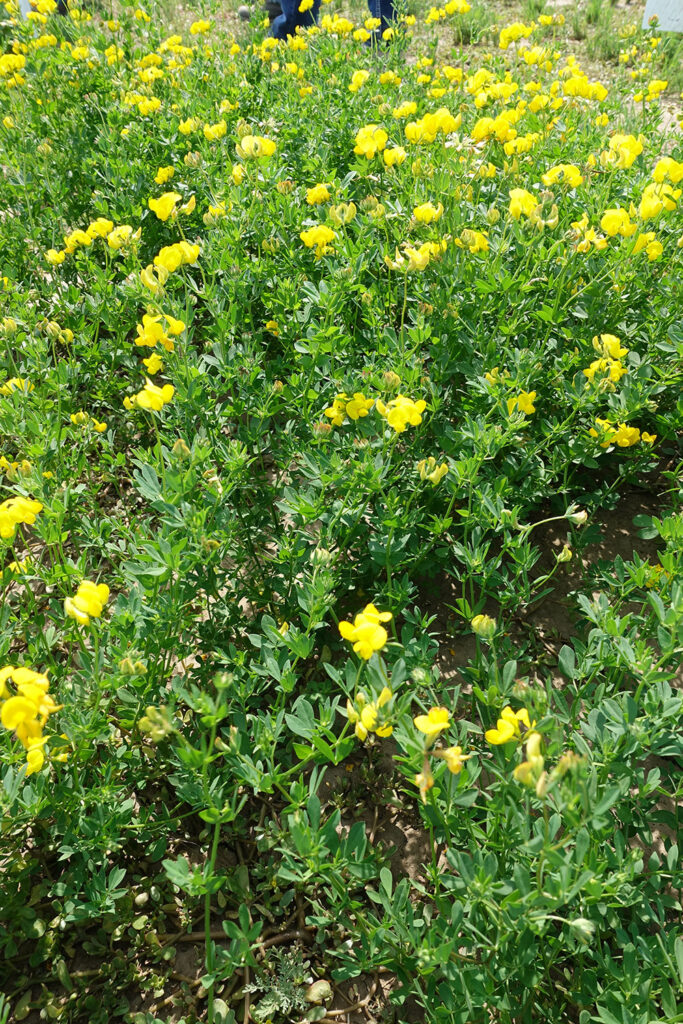
Native Species
Native species are those that were not introduced from other areas or continents.They are found naturally in the ecosystem and are well adapted to local environmental conditions. Temperate grasslands cover approximately eight percent of the Earth’s land surface, and with over 50 percent now converted to crops or other land uses, they have been declared the world’s most endangered ecosystem2. Estimates suggest over 80 percent of Canada’s prairie grasslands have been converted to alternate land use systems3.
Native stands often have improved soil properties such as lower soil bulk density, higher organic matter and less weed invasion than tame forage stands. Many native stands contain a mixture of cool season and warm season grasses and legumes which offer varying levels of nutrition, palatability and corresponding production benefits. Native grasses have relatively low input costs to maintain compared to tame grasses and exhibit superior drought tolerance. The biodiversity and multiple species present in rangelands also provides some disease resistance and adaptability to varying environmental conditions.
While cool season native species, such as needlegrass, wheatgrasses, and fringed bromegrass are dominant in many Canadian rangelands, warm season plants such as bluestems and blue grama are present on many drier, sandy soils4. Native plant population diversity increases primary production, improves the ecosystem’s ability to adapt to disturbances and improves nutrient cycling. With a diverse range of native species, yield is distributed throughout the growing season, offering improved production and providing cattle with nutritious, palatable forage. When native legumes are included in a diverse mixture, they also provide a protein source for cattle.
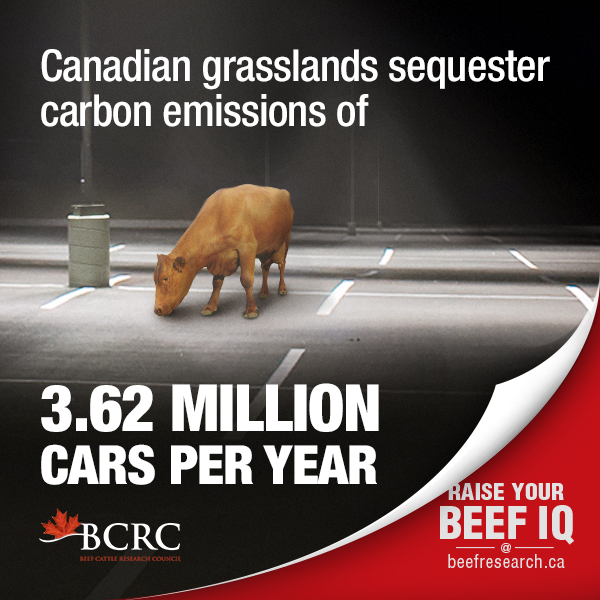
Because native species may increase carbon sequestration, improve wildlife habitat, lower agronomic inputs, and extend the grazing season, there is a growing interest in the use of native perennial species for seeded rangeland and reclamation following disturbance. Diverse forage swards composed of native species have the potential to be as productive as tame monocultures in a greater range of environmental conditions. Research conducted at Saskatoon and Swift Current, Saskatchewan, led by Dr. Mike Schellenberg, examined productivity and protein levels in several forage mixtures of warm and cool season grasses and legumes and compared them to monocultures. Read more about this work here.
Some examples of native grasses include June grass, awned wheatgrass, big bluestem, little bluestem, northern wheatgrass, slender wheatgrass, switchgrass, blue grama, side-oats grama, salt grass, western wheatgrass, needle and thread grass and green needle grass. Native legumes include Canadian milk vetch and white and purple prairie clovers.
In Ontario, Quebec and Atlantic Canada, native cool and warm season grasses and legumes grow within each respective province. However, their use in animal or forage production is limited compared to the use of forages introduced by early settlers. The yield from native forages tends to be lower than the yield from introduced species but they can have superior environmental resiliency and persistence.
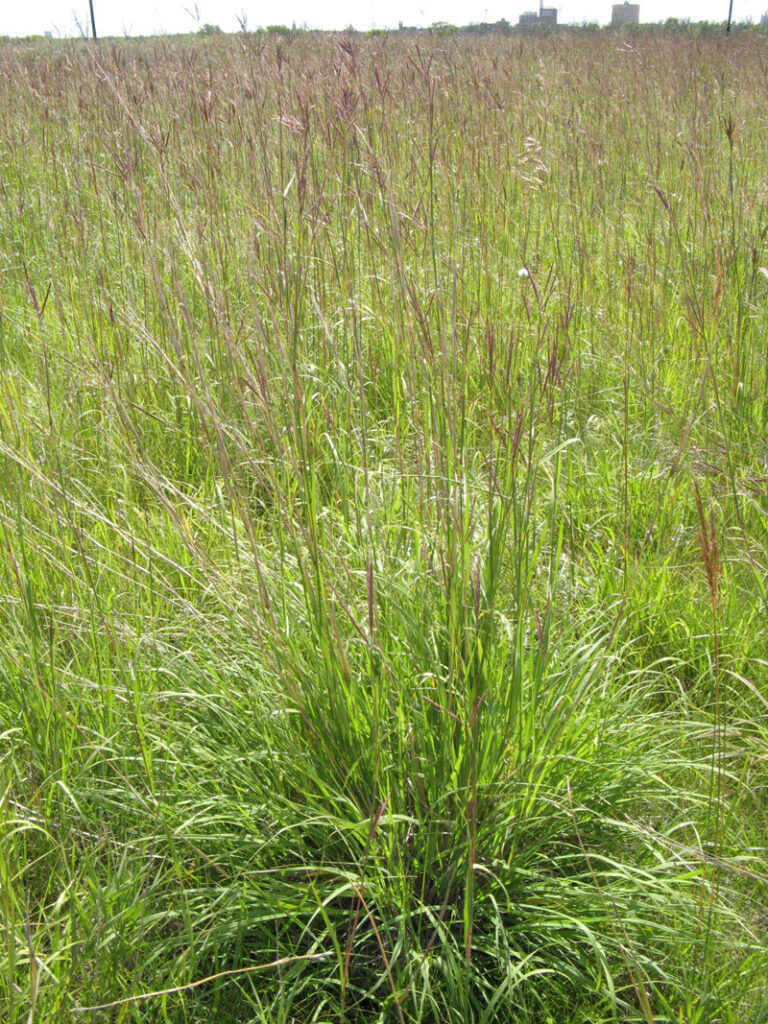
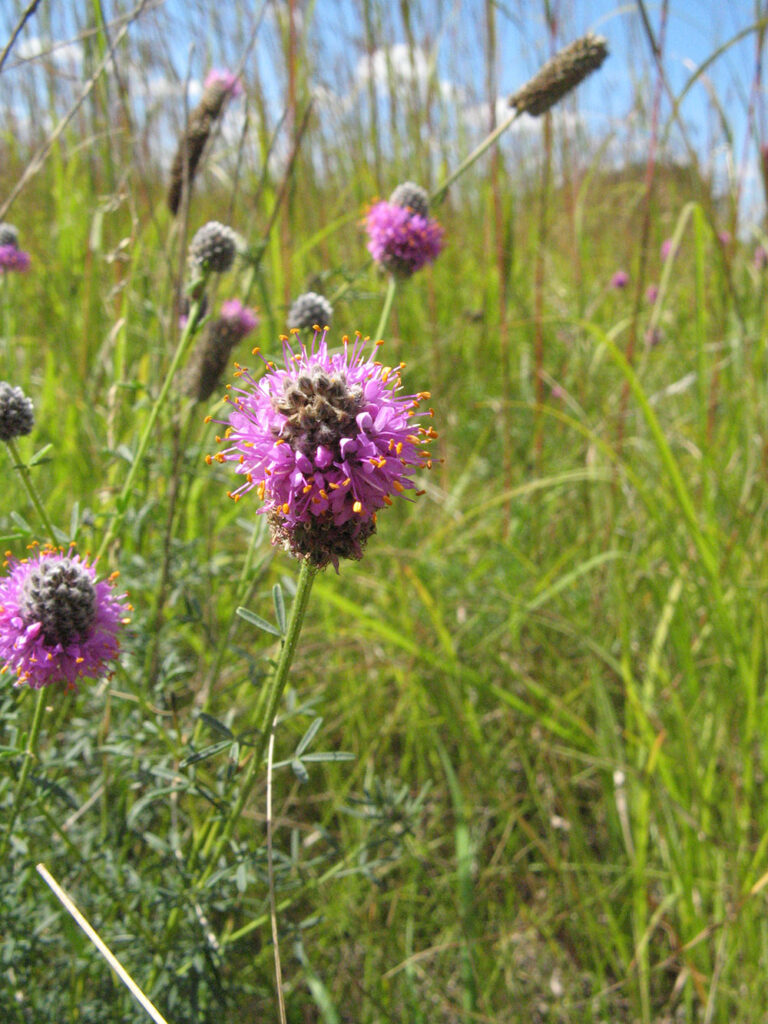
Forage Species Selection
A wide range of grasses and legumes are adapted for use across Canada, with each species’ particular characteristics determining suitability for the chosen end use.
Many factors must be considered when making a forage selection. Stand mixtures should be appropriate for the soil, acclimatized to the region, and be able to withstand management intentions and pressures (i.e., silage/haying/grazing). When matching forage species to the characteristics of the soil, consider drainage, fertility, salinity and pH. Soil maps and information that describe the limitations of a particular soil type are helpful, especially for land that has not been previously managed.
An interactive Forage Species Selection Tool (Forage U-Pick) is available to assist land managers in selecting the correct forage species best suited to their climate, soil conditions and management goals. Seeding rate and seed cost calculators plus information about weeds are integrated within the tool as well.
The following webinar, Sprouting Technology, provides an overview of the Forage U-Pick Selection Tool including information on numerous forages suitable for western Canada.
Mixtures vs. Pure Stands
To determine whether a single species or a mixture provides the best option for a forage stand, producers need to consider many factors. Single species work well for single end uses. Mixtures like grass-legume blends can require more complex management but provide a range of benefits such as improved yield and nutritional quality, adaptability and resilience to growing conditions and improved weed control when harvested for hay or silage, or used for grazing.
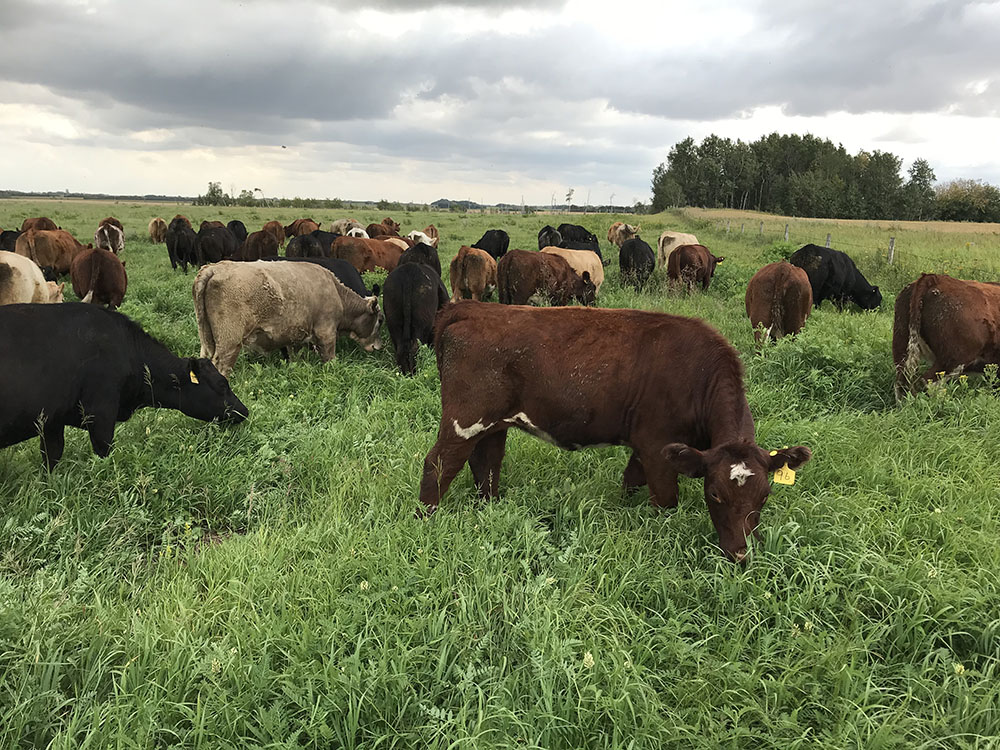
To increase protein levels and digestibility of forage, producers often consider a forage mixture that contains a legume such as alfalfa or red clover. Grass species that grow well when planted with alfalfa include bromegrasses, timothy, crested wheatgrass, orchard grass and tall fescue. Grasses that grow well with red clover can include smooth bromegrass, timothy, orchard grass, perennial ryegrass, tall fescue or reed canary grass. Mixtures containing 30-40% legume can usually produce enough nitrogen for stand needs, reducing the need for regular applications of nitrogen fertilizer. Grass-legume mixtures can reduce risk of bloat, while increasing the length of the grazing season. When legumes are inoculated with rhizobia, a group of common soil bacteria, small nodules form on the roots and convert nitrogen gas from the atmosphere into nitrogen that the plants can utilize. A mixture of a grass and an inoculated legume can be advantageous and more economical than a pure grass or legume stand for the following reasons:
- Eliminates or reduces the need for nitrogen (N) fertilizer on pure grass stands because a properly inoculated legume in the mixture will also provide nitrogen for grass growth.
- Lengthens the life of the pasture or hayland because the grass will remain after the legume stand is reduced. If desired, a legume can be reintroduced by pasture rejuvenation.
- Reduces the problem of legumes “heaving,” whereby legumes are raised from the soil surface by freeze-thaw action in the late winter and early spring, resulting in plant damage. The extensive fibrous roots of the grasses hold the legume plants in place.
- Reduces soil erosion on steep slopes. The fibrous root system of grasses assists with soil conservation better than pure legume stands.
- Improves livestock performance. A grass-legume mixture can improve animal gain and cattle breeding performance over a pure grass stand. A grass mixture can also reduce animal performance problems associated with bloating on alfalfa.
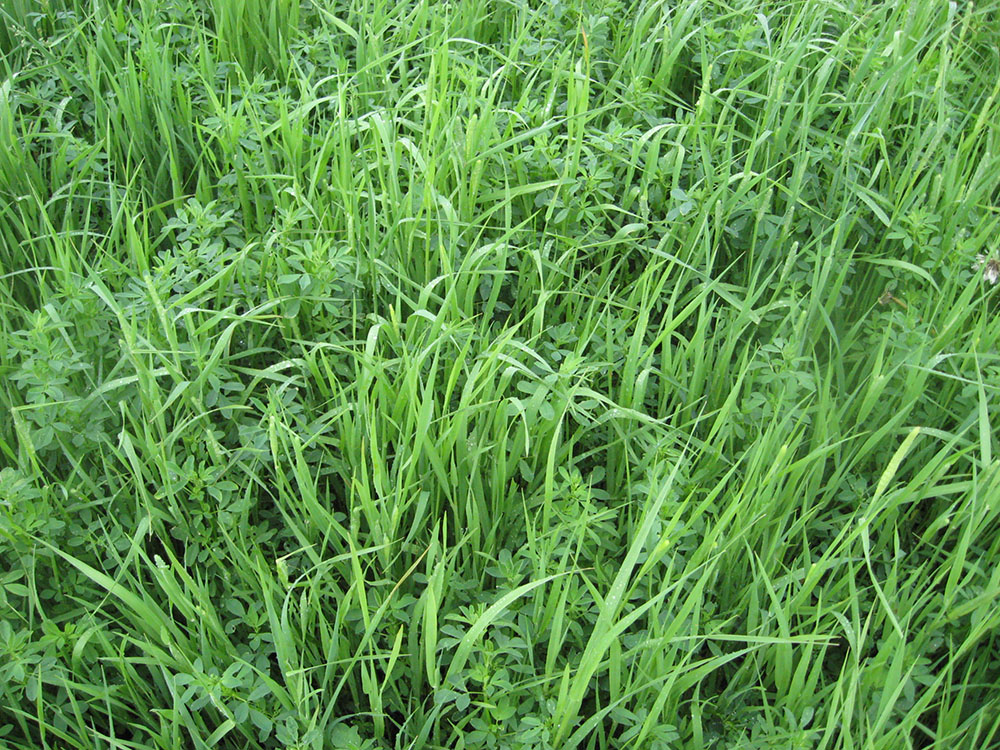
Mixed stands of grasses or legumes are generally more resilient than single species stands. When conditions occur where one species suffers, another species may be better adapted. This is particularly important when grazing will occur at various times throughout the grazing season or if the intention is for the stand to remain productive for a long time period.
In some cases, a pure grass stand or a pure legume stand may be advantageous over a grass-legume mixture:
- Single species stands ease the management associated with trying to keep all species competitive in a mixture. They often work well when a producer’s objectives are specific, for example haying only. The most suitable species can then perform under that particular management program for the specific goal, and for a specific time.
- Pure grass or legume stands increase the number of herbicide options available for weed control. Weed control options are reduced in grass-legume stands.
- A pure legume stand is often higher in forage quality than a pure grass stand or a grass-legume mixture.
Research is ongoing to determine which forage species mixtures have the greatest potential to improve beef production from forages. Recent research by Yousef Papadopoulos examined the relationship between yield, nutritional value and animal gain with several different mixtures, including binary and complex mixtures in Eastern and Central Canada.
Establishing new pastures can be expensive and producers often prioritize stand life over yield. Seeding complex mixtures of grasses and legumes that maintain highly diverse botanical composition in pastures can contribute to increased persistence, yield stability and improved productivity. Yields benefit from including highly productive as well as drought-tolerant species. While some species will not persist beyond the first three or four years, other species in the mix can fill in the gap to maintain overall yields, to varying degrees. The use of certified seed or mixtures containing certified seed can allow producers to take advantage of recent advances in forage breeding efforts.
Management of Forage Stands
Management of a forage stand relies upon optimizing the level of utilization that allows for maximum forage use without damage or negative impact to the forage plant, including both above and below ground growth. The condition of the forage stand impacts carrying capacity and the length of time that livestock can graze, or the numbers of cuts that can be obtained, if harvesting for silage or hay.
The primary use objectives for the stand and field conditions will determine the blend of species selected. Producers must balance plant diversity, in season productivity and flexibility of use as part of effective stand management. Well managed pasture with a significant legume component is one of the most sustainable feed sources for cattle. It is often the most profitable for producers because the nutritive value of the mixture meets livestock demands and can produce suitable animal gains with fewer inputs.
As pasture matures, quality often declines. The leaf percentage decreases, stem percentage increases, protein and energy decrease, fibre and lignin increase, and intake decreases to compensate for the longer rumination time required to breakdown more mature forages. Timing of grazing or harvesting will impact digestibility and forage quality.
Delayed harvest can allow more carbohydrate and nitrogen storage in roots of upright-growing legumes or in the lower plant parts of grasses, which supports regrowth vigour and persistence5. Vigorous plants are more competitive with weeds and other species resulting in better plant persistence, especially the proportion of desirable legume plants within mixed swards. Harvest management requires compromises to produce the largest quantity of a quality product for the desired number of years while monitoring undesirable weed incursion.
Fall management is important when plants are storing carbohydrates. For certain legume species, for example, cutting or grazing four to six weeks before the first killing frost can interfere with carbohydrate storage. This lowers the winter hardiness of the legume plant, which may result in poorer, lower yielding stands the following spring due to winter damage and lower energy storage in the roots and crowns. Without stored carbohydrate energy over winter, new spring growth is delayed, and plants are less vigorous. Late summer grazing or cutting should be timed in order to provide a fall rest period.
Plants go through three phases of growth, as illustrated in the table below and as explained further here. Fluctuations in forage nutrient content are correlated with the growth cycle of the forage. Grazing and rest periods that target activity in Phase 2 will yield the best results. When forages are grazed and return to Phase 1, adequate rest and recovery must occur to allow for regrowth and to prevent the forage stand from being compromised. If forages reach Phase 3, they become more mature, fibrous, and less nutritious. Create a grazing plan that aligns the forage species and their growth patterns with timing of use for maximum nutrition, yield and desired stand utilization and longevity.
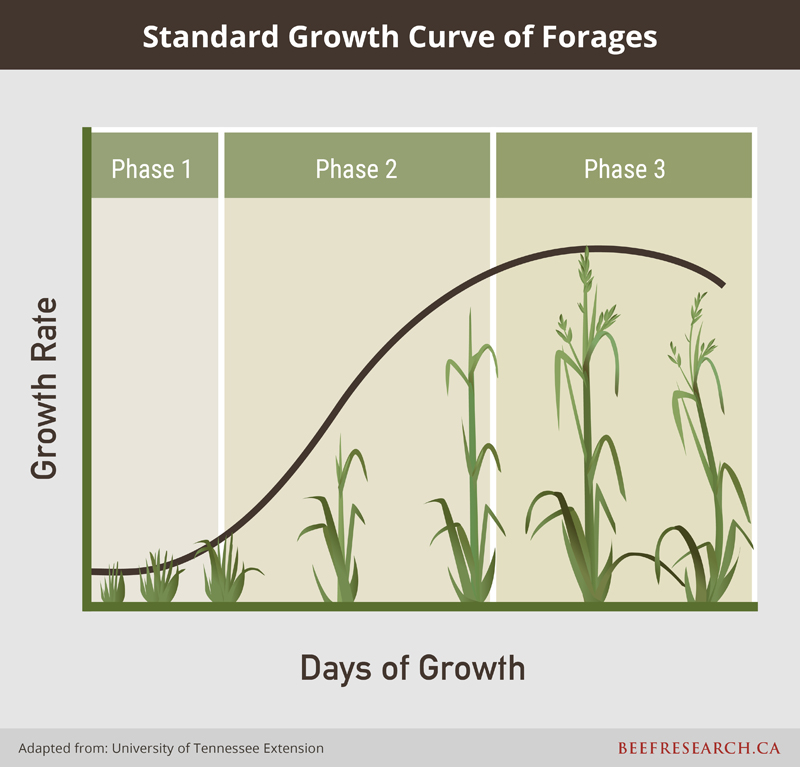
When rangelands consist of mainly warm season forages, their annual growth occurs later in the season. Native pastures are sensitive to overgrazing and require careful management. They are best grazed once they have adequate new growth, and, as with all forage species, require an adequate rest period to restore root reserves. When considering timing of grazing and managing forage stands, consider the growth period of the forages and the relative yield. Producers who graze native rangelands often utilize early growth tame forages such as crested wheatgrass or wildrye grass in the spring and turn cattle into native rangelands once the cool season forages decline in productivity. The table below, which illustrates averages for Saskatchewan, provides examples of yield and growth for some different forages.
Figure 3 – Relative yield of native grass and seeded pastures.
Canadian Forage Breeding Programs
Pasture, hay and silage of perennial and annual forage crops provide the majority of feed for Canadian beef cattle. Cattle producers need access to high yielding, high quality, and well adapted varieties to improve the economics of production. Canadian plant breeding programs have developed many improved varieties of a number of grass and legume species.
Over the long term, improving forage productivity is crucial for future competitiveness of the cattle industry. While it may be more profitable for a producer to obtain hay or pasture from another source in the short term (buy or rent land or purchase hay), reducing the per unit cost of production (COP) through improvements in yield and quality will improve profitability in the long term. Current competition for land is putting further pressure on the forage industry to increase margins or risk conversion into more profitable land uses. This makes forage breeding a key piece to the long-term sustainability of the beef industry.
It can take up to ten years to develop a market ready forage variety. Consistent investment in breeding programs provides a source of new varieties suited to the local environment with incremental improvements in yield, longevity, disease, and drought resistance. This requires:
- an ongoing investment in research capacity (forage breeders and infrastructure) to focus on development of varieties suited for Canadian soils and climatic conditions,
- collaboration among regional breeding programs and an adequate number of testing sites to identify varieties that perform well in other environments, and
- a regulatory system that supports registration and commercialization of new varieties.
Higher forage yield remains a goal of Canadian tame forage breeding programs. Persistence, winter hardiness, disease resistance, drought or other stress (salinity, flooding, etc.) tolerance and improved nutritive value have also been goals of certain breeding programs.
Many improved varieties have been released from Canadian forage breeding programs over the years. A few examples of varieties that have had a significant impact include:
Sainfoin is a high quality, non-bloating forage legume; however, without careful grazing management, it can disappear from a stand within a few years. Condensed tannins in the plant are very effective at preventing bloat in ruminants. Breeding efforts are focused on sainfoin that regrows more rapidly after grazing, has improved yield, and persists longer in mixtures with alfalfa. Releases include AAC Mountainview and AAC Glenview with research ongoing to develop additional varieties.
Meadow bromegrass was released in Canada in 1980. Fleet and Paddock, the first Canadian developed varieties, released by Agriculture and Agri-Food Canada (AAFC) Saskatoon in 1987, had higher forage and seed yield compared to traditional cultivars. This led to meadow bromegrass becoming the leading pasture grass in western Canada, highly valued for its rapid regrowth throughout the growing season. New high yielding cultivars have been released and others are under development.
Winter hardy alfalfa has been a priority for AAFC Ste-Foy leading to the release of many persistent alfalfa cultivars, including Apica and Caribou. They have been well adapted and grown across Canada.
Extreme winter weather tolerant alfalfa was bred in Nova Scotia at the Nappan Research Station and recieved registration in 2018. This cultivar is a branch rooted alfalfa that can withstand periods of dryness, wetness or flooding, and has a unique rhizomatous growth habit.
Red clover is an important forage species on wetter, more acidity prone soils found in eastern Canada. Red clover is susceptible to many diseases, which makes it short-lived. The breeding program at AAFC Kentville has released a number of new red clover cultivars that are more persistent, with improved disease resistance than older cultivars.
Birdsfoot trefoil cultivars were developed by the Nappan Research Station in Nova Scotia. Registered cultivars were selected for improved seedling vigor, a common issue with older cultivars, spring growth and seasonal yield.
Cicer milkvetch is a forage legume that does not cause bloat in grazing animals, but it’s use has been limited by the difficulty of establishing good stands. Cultivars released by AAFC Lethbridge, Oxley II and Veldt, have improved seedling vigour which makes stand establishment easier.
Canadian breeding programs continue to conduct research in areas such as:
- grasses with higher biomass production
- hybrid bromegrass with improved digestibility
- sainfoin with faster regrowth and more persistence for use in mixtures with alfalfa
- timothy with higher production per unit of nitrogen
- alfalfa with condensed tannins in leaves to reduce bloat
- alfalfa with higher lipid (fat) content in the leaves to increase energy
- dual purpose hybrid bromegrass to be used for haying and pasture
- improving seed production for a number of native species
These are just a few examples of the many areas of research focus that are ongoing with many more advancements being investigated and initiated.
Conclusion
The livestock industry relies upon many forage species for a stable and efficient feed source. Forages are grazed, hayed, swathed, baled, stockpiled and ensiled. The different yields, growth patterns and nutritional profiles of individual species can impact the productivity of beef cattle. Annual and perennial forage species can be used individually or in simple or diverse mixtures. Producers must determine appropriate forages to fit their operational needs within their local climate and soil conditions.
- References
-
1. Statistics Canada Census of Agriculture. 2016.
2. Oregon State University, Forage Information System. Define the utilization of legumes in forage-livestock systems. https://forages.oregonstate.edu/nfgc/eo/onlineforagecurriculum/instructormaterials/availabletopics/legumes/utilization
3. Temperate Grasslands Conservation Initiative. Peart, B. 2008. Life in a Working Landscape: Towards a Conservation Strategy for the World’s Temperate Grasslands
4. Samson, F.B. and F.L. Knopf. 1996. Prairie conservation. Preserving North America’s most endangered ecosystem. Island Press. Washington D.C., USA. 339 pp.
5. Wark, D.B., L.K. Gabruch, C. Penner, R.J. Hamilton and T.G. Koblun. Revegetating with Native Grasses in the Northern Great Plains.6. Nelson, C.J., D.D. Redfearn, and J. H. Cherney. Forage Harvest Management. University of Missouri.
Acknowledgements
Thanks to Dr. Bruce Coulman for his expertise in reviewing this information and for providing content specific to Canadian forage breeding programs.
Feedback
Feedback and questions on the content of this page are welcome. Please e-mail us.
This content was last reviewed January 2024.
